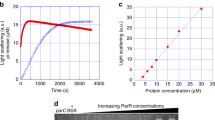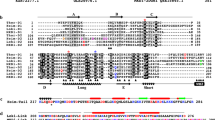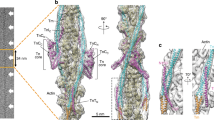Abstract
ACTIN and myosin from muscle combine to form filaments with a distinctive arrowhead appearance1. Filaments from several lower organisms2–5 and from cells other than muscle in higher animals6–9 also react with muscle myosin or its subfragments to produce arrowhead filaments. This ability to bind muscle myosin has become accepted as a test for the identification of the filaments as actin. Its validity is supported by the chemical similarities between those actins which have been further characterised5,6,8–13, and by the need for the myosin binding sites to be quite specifically positioned and oriented for the arrowhead effect to arise14. A filament reacting with heavy meromyosin subfragment one (S1) has now been detected in cells of the green alga, Chara corallina.
This is a preview of subscription content, access via your institution
Access options
Subscribe to this journal
Receive 51 print issues and online access
$199.00 per year
only $3.90 per issue
Buy this article
- Purchase on Springer Link
- Instant access to full article PDF
Prices may be subject to local taxes which are calculated during checkout
Similar content being viewed by others
References
Huxley, H. E., J. molec. Biol., 7, 281 (1963).
Nachmias, V. T., Huxley, H. E., and Kessler, D., J. molec. Biol., 50, 83 (1970).
Pollard, T. D., Shelton, E., Weihing, R. R., and Korn, E. D., J. molec. Biol., 50, 91 (1970).
Pollard, T. D., and Korn, E. D., J. Cell Biol., 48, 216 (1971).
Woolley, D. E., Archs Biochem. Biophys., 150, 519 (1972).
Bray, D., Cold Spring Harb. Symp. quant. Biol., 37, 567 (1972).
Bettex-Galland, M., Probst, E., and Behnke, O., J. molec. Biol., 68, 533 (1972).
Yang, Y., and Perdue, J. F., J. biol. Chem., 247, 4503 (1972).
Tilney, M. G., and Mooseker, M., Proc. natn. Acad. Sci. U.S.A., 68, 2611 (1971).
Hatano, S., and Oosawa, F., Biochim. biophys. Acta., 127, 488 (1966).
Weihing, R. R., and Korn, E. D., Biochemistry, N.Y., 10, 590 (1971).
Booyse, S. M., Hoveke, T. P., and Rafelson, M. E., J. biol. Chem., 248, 4083 (1973).
Fine, R., and Bray, D., Nature new Biol., 234, 115 (1971).
Moore, P. B., Huxley, H. E., and deRosier, D. J., J. molec. Biol., 50, 279 (1970).
Nagai, R., and Rebhun, L. I., J. ultrastruct. Res., 14, 571 (1966).
Pickett-Heaps, J. D., Aust. J. biol. Sci., 20, 539 (1967).
Bradley, M. O., J. Cell Sci., 12, 327 (1973).
Parthasarathy, M. V., and Muhlethaler, K., J. ultrastruct. Res., 38, 46 (1972).
Author information
Authors and Affiliations
Rights and permissions
About this article
Cite this article
WILLIAMSON, R. Act in the alga, Chara corallina. Nature 248, 801–802 (1974). https://doi.org/10.1038/248801a0
Received:
Issue Date:
DOI: https://doi.org/10.1038/248801a0
This article is cited by
-
The sliding theory of cytoplasmic streaming: fifty years of progress
Journal of Plant Research (2007)
-
Plant myosins
Protoplasma (2000)
-
From pollen actin to crop male sterility
Chinese Science Bulletin (2000)
-
Actin in living and fixed characean internodal cells: identification of a cortical array of fine actin strands and chloroplast actin rings
Protoplasma (1996)
Comments
By submitting a comment you agree to abide by our Terms and Community Guidelines. If you find something abusive or that does not comply with our terms or guidelines please flag it as inappropriate.



